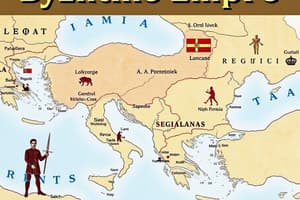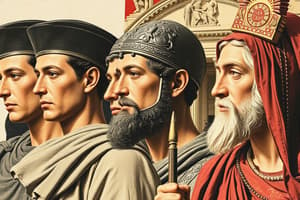Podcast
Questions and Answers
Why did the Western Roman Empire collapse?
Why did the Western Roman Empire collapse?
The empire declined, split, and collapsed due to constant Germanic invasions along with social, economic, political, and military factors.
What ended the Pax Romana?
What ended the Pax Romana?
The Pax Romana ended in 180 CE.
What were some military factors that contributed to the fall of Rome?
What were some military factors that contributed to the fall of Rome?
Constant attacks on borders, reliance on mercenaries, and disloyalty within the army.
What was one reason for the spiraling economic crisis in Rome?
What was one reason for the spiraling economic crisis in Rome?
The reason for the Empire's decline can be summarized as: Political instability -> Military conflict -> Economic crisis -> ______
The reason for the Empire's decline can be summarized as: Political instability -> Military conflict -> Economic crisis -> ______
Match the cause with its effect during the Roman Empire's decline:
Match the cause with its effect during the Roman Empire's decline:
Who governed as an absolute ruler and divided the Roman Empire?
Who governed as an absolute ruler and divided the Roman Empire?
What city did Constantine the Great move the capital to?
What city did Constantine the Great move the capital to?
What social factors contributed to the collapse of the Roman Empire?
What social factors contributed to the collapse of the Roman Empire?
What economic issues faced the Roman Empire leading to its collapse?
What economic issues faced the Roman Empire leading to its collapse?
Who were the two key enemies of Rome?
Who were the two key enemies of Rome?
How did Attila the Hun impact the Roman Empire?
How did Attila the Hun impact the Roman Empire?
What happened to the population of Rome after 455 CE?
What happened to the population of Rome after 455 CE?
What event marked the official fall of the Western Roman Empire?
What event marked the official fall of the Western Roman Empire?
What became of the Eastern Roman Empire after the collapse of the Western Roman Empire?
What became of the Eastern Roman Empire after the collapse of the Western Roman Empire?
What was one decision of the emperor that upset the Romans during the inflation crisis?
What was one decision of the emperor that upset the Romans during the inflation crisis?
Why did Rome begin to lose territory after the Pax Romana?
Why did Rome begin to lose territory after the Pax Romana?
Where did Constantine move the capital of the Roman Empire?
Where did Constantine move the capital of the Roman Empire?
Flashcards are hidden until you start studying
Study Notes
Causes of the Fall of the Western Roman Empire
- The Western Roman Empire collapsed due to constant Germanic invasions and a combination of social, economic, political, and military factors.
- The Pax Romana, a long period of relative peace, ended in 180 CE, leading to political instability.
- From 235 to 284 CE, the empire experienced rule by nineteen different emperors.
Political Problems
- Increased political upheaval and violence were prevalent post-Pax Romana.
- The loss of central authority weakened governance and public trust.
Military Factors
- Roman territorial losses amplified due to continuous border attacks.
- Reliance on mercenaries increased as loyalty within the army diminished.
Economic Crisis
- Emperors created more coins to generate revenue, leading to inflation as the value of currency declined.
- Taxes on Roman citizens rose sharply, causing financial distress.
Decline Process
- A cycle of political instability, military conflict, economic crisis, and social decay catalyzed the empire's decline.
Key Causes and Effects
- The end of the Pax Romana triggered political and economic instability, inflation, and reliance on mercenaries due to insufficient Roman soldiers.
Emperor Diocletian (245-316 CE)
- Governed with absolute power; divided the empire into eastern and western parts.
- Standardized coins and fixed prices to stabilize the economy temporarily.
- The Eastern Roman Empire enjoyed more wealth, thanks to intact trade routes and lesser invasions.
Constantine the Great
- Unified both halves of the empire and moved the capital to Byzantium, renaming it Constantinople.
- Converted to Christianity, promoting tolerance and ending the persecution of Christians.
- After his death, the Western Empire faced renewed decline.
Social Factors Leading to Collapse
- Diminished patriotism and limited public engagement in government affairs were notable social issues.
- Growing wealth disparities and loss of faith in the empire's ability to provide safety contributed to societal decline.
Economic Factors Contributing to Decline
- Bad harvests, disrupted trade, high taxes, and inflation increased the divide between the rich and poor.
Enemies of Rome
- The Huns from Central Asia and Germanic tribes from Eastern Europe posed significant threats to Roman security.
The Huns
- Attila the Hun led attacks with 100,000 troops against over 70 cities but failed to capture Rome or Constantinople.
Collapse of Western Rome
- Germanic invasions led to the looting of Rome in 455 CE and a drastic decline in population.
- In 476 CE, a German king deposed the last Western Roman emperor, marking the official end of the Western Roman Empire.
The Decline and Fall Timeline
- 27-180 CE: Pax Romana established.
- 117 CE: The Roman Empire reached its maximum territorial extent.
- 284 CE: Diocletian divided the empire for better governance.
- 330 CE: Constantine moved the capital to Byzantium.
- 370 CE: Hun invasions began.
- 476 CE: Fall of the Western Roman Empire.
Aftermath of the Fall
- Following the collapse of the Western Roman Empire, the Eastern Roman Empire transformed into the Byzantine Empire, which persisted until 1453.
Diocletian's Contributions to Order
- Diocletian provided short-term stability by implementing a division of the empire into eastern and western regions.
Inflation Impact on Citizens
- The introduction of more coins caused prices to rise, requiring citizens to spend more for the same amount of goods, leading to widespread discontent.
Loss of Territory
- The expansive borders of the Roman Empire were highly vulnerable, facing non-stop attacks post-Pax Romana.
Constantinian Reforms
- Constantine's establishment of Constantinople marked a significant shift in the empire's power center and paved the way for the Byzantine Empire's formation.
Studying That Suits You
Use AI to generate personalized quizzes and flashcards to suit your learning preferences.




